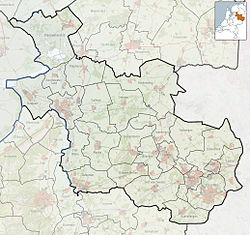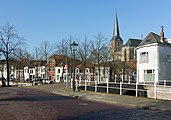Bovenkerk, Kampen
| Bovenkerk | |
|---|---|
 View of the Bovenkerk and the Koornmarktpoort, Kampen | |
| Religion | |
| Affiliation | Reformed |
| Province | Overijssel |
| Location | |
| Location | Koornmarkt 28, Kampen, Netherlands |
| Municipality | Kampen |
| Geographic coordinates | 52°33′18″N 5°55′13″E / 52.555°N 5.920278°E |
| Architecture | |
| Type | Church |
| Style | Gothic |
| Capacity | 1250 |
| Website | |
| http://www.debovenkerk.nl | |
The Bovenkerk (English: Upper Church; also known as the Church of St. Nicholas) is a large, Gothic church and the most striking element on the skyline of Kampen, Overijssel, Netherlands. The interior of the church contains an early-Renaissance choir screen, a stone pulpit and a monumental organ. The church has 1,250 seats. It is a Reformed church.[1]
The Construction
The construction of the church took place in several phases:
- Construction of a Romanesque church (12th century)
- Construction of Early Gothic church (last quarter of 13th century)
- Church gets a basilica choir (last quarter of 14th century)
- Plan for a basilica nave fails (early 15th century)
- The construction is completed (second half 15th century)
Graves
A common practice for old historic churches was to bury the dead under the Church. The Bovenkerk is no exception to this practice, where famous Dutch persons originating from Kampen are buried. One of them is Hendrick Avercamp (1585-1634), one of the first landscape painters of the 17th-century Dutch school, specialized in painting the Netherlands in winter. The transept contains a small ornament of red marble with a green marble urn in memory of Vice Admiral Jan Willem de Winter (1761-1812). The heart of Vice Admiral De Winter is enclosed in this urn, while his body is buried in the Panthéon in Paris.[2]
Gallery
-
Thje Bovenkerk from the Prinsenstraat-Burgwal
-
The Bovenkerk from the Vloeddijk-Venestraat
-
The Bovenkerk from the Vloeddijk-Muntsteeg
References
- ^ Official website (in Dutch).
- ^ Chisholm 1911.
- Attribution
- This article incorporates text from a publication now in the public domain: Chisholm, Hugh, ed. (1911). "De Winter, Jan Willem". Encyclopædia Britannica. Vol. 28 (11th ed.). Cambridge University Press.




